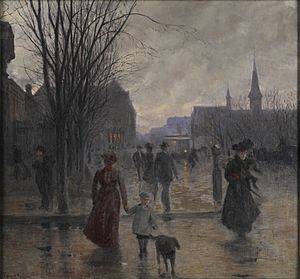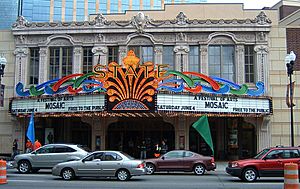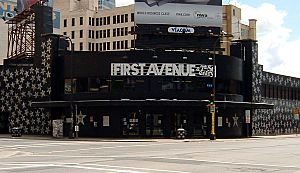Arts in Minneapolis facts for kids
Minneapolis is the biggest city in the US state of Minnesota. It's also the main city of Hennepin County.
People in Minneapolis love art and culture! The city has many large museums. These include places for art, science, and history. There are also smaller galleries and museums. Minneapolis is home to several ballet, dance, and folkdance groups. Many theater companies and filmmaking groups also thrive here. The city even has a plan called The Minneapolis Plan for Arts and Culture. This plan helps support and grow the arts. For example, it officially recognized the Northeast Arts District.
Contents
Visual Art in Minneapolis

The Minneapolis Institute of Arts (MIA) is a big art museum. It was started in 1883. The museum is near the Minneapolis College of Art and Design. The first building opened in 1915. It was designed by a famous New York architecture firm. The MIA grew in 1974 with a new part designed by Kenzō Tange. In 2006, another new wing opened. This part was designed by Michael Graves.
The city's Park Board worked with the Walker Art Center. Together, they created the outdoor Minneapolis Sculpture Garden. It's near downtown Minneapolis. The Walker Art Center also expanded. Its north wing opened in 1971. A big expansion in 2005 doubled the museum's size. It added new galleries, a restaurant, and a theater.
The Weisman Art Museum is on the University of Minnesota campus. It has many different art pieces. These include early American modern art and Asian furniture. The museum building itself is special. It's made of shiny stainless steel. Frank Gehry designed this unique building.
Years ago, the Warehouse District was full of artist studios. Many art galleries were there in the 1980s and early 1990s. But rents became too high. New buildings and shops moved in. So, many artists and galleries moved away. Some went to other parts of Minneapolis. Others moved to Lowertown in Saint Paul.
Even with these changes, the Warehouse District still has art. You can find studio buildings and art galleries there. The Traffic Zone Center for Visual Art (TZCVA) is one example. It's an artist group and exhibition space. It started in 1995. The Handicraft Guild is another old artist group. It was founded in 1904. It's located near the Target headquarters.
Today, Northeast Minneapolis is a lively art area. The Northeast Minneapolis Arts District was created in 2001. The Northeast Minneapolis Arts Association also supports artists. They have special events like Art-a-Whirl in May. The Art Attack happens in November. These events let you visit artists' studios. The Stone Arch Festival is held by the river. Other art fairs happen in August. These include the Uptown Art Fair and fairs in Loring Park and Powderhorn Park.
The Minnesota Center for Book Arts teaches old crafts. They focus on making paper by hand. They also teach letterpress printing and bookbinding. They support artists who use these skills. Juxtaposition Arts is a visual art center for young people. It's located in the Jordan neighborhood.
Beyond the Sculpture Garden, you can find outdoor art. One example is Jeff Barber's Cottontail on the Trail. There's also a statue of Mary Tyler Moore on Nicollet Mall.
Music in Minneapolis
Minneapolis offers all kinds of live music. Famous artists have played here. Bob Dylan, who is from Minnesota, played folk music in Dinkytown. Classical music is performed at Orchestra Hall. Smaller places like the Bakken Library and Museum also host music.
The Minnesota Opera moved back to Minneapolis in 1990. It's one of several opera companies in the area. Big concerts happen at stadiums and theaters. They bring in top musicians from around the world. The MacPhail Center for Music teaches music. It was founded in 1907. It built new facilities near the Mississippi River in 2006.
Prince is Minneapolis's most famous musician. He and other local artists helped make First Avenue a very important music spot. Many bands from Minneapolis became well-known. These include The Time, The Replacements, and Hüsker Dü.
The city is also known for rap and hip hop. Groups like Atmosphere are popular. Many hip-hop artists are on the independent label Rhymesayers Entertainment. These include P.O.S, Eyedea, and Brother Ali. Minneapolis also has a lively spoken word community. Poets often perform at live music venues. The Minnesota Boychoir has been part of the local music scene for over 50 years.
Theater in Minneapolis

The Twin Cities (Minneapolis and Saint Paul) have a very active theater scene. It's the third-largest theater market in the U.S. after New York City and Chicago. Many theater companies are here. Some examples are the Jungle, Mixed Blood, and the Children's Theatre Company.
The Guthrie Theater is a major theater. It moved to a new building in 2006. This building was designed by Jean Nouvel. It has three stages for different types of shows. One stage has 1,100 seats. Another has 700 seats, and a smaller one has 200 seats. A long bridge from the theater reaches over to the Mississippi River. Visitors can walk on it during certain hours. The founder, Tyrone Guthrie, wanted new and exciting plays.
Minneapolis bought and updated three old theaters. These are on Hennepin Avenue. They are managed by a non-profit group. The Orpheum (2,618 seats), the State (2,181 seats), and the Pantages (900 seats) were built between 1916 and 1921. They used to show vaudeville acts and movies. Now, they host concerts and Broadway shows.
Literature in Minneapolis
The Loft Literary Center started in 1974. The Playwrights' Center also supports writers. These places help many writers, poets, and playwrights in the area.
Dance in Minneapolis
Minneapolis has many dance and performance groups. These groups offer different styles of dance. The James Sewell Ballet is one example. Another is Cheer, Dorothy, Cheer!, a group that performs cheerleader-inspired routines.
The historic Shubert Theatre building was moved. It was physically moved three blocks to a new spot. It's now next to the Hennepin Center for the Arts. The Shubert (now called Goodale Theater) and the Hennepin Center for the Arts joined together. They formed the Cowles Center for Dance and the Performing Arts.




